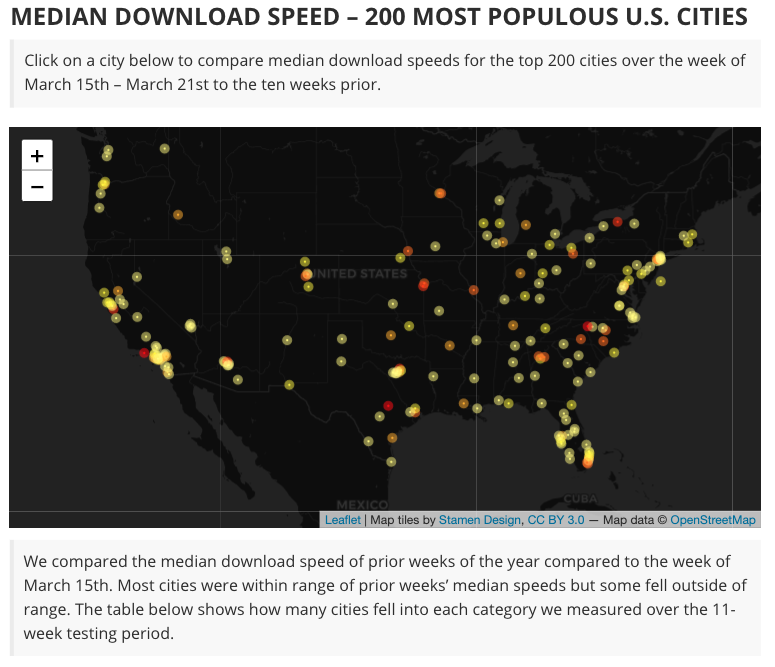New York Internet Speeds Have Plunged As Locked-Down Americans Clog Networks
Download speeds for some US internet users have been bogged down in recent weeks as millions of Americans work from home due to ‘shelter-in-place‘ public health orders enforced by federal and state governments.
Some folks have resorted to “Netflix and quarantine” and free Pornhub Premium, both are streaming video sites that are data intensive.
As an economic depression rolls in, millions have just lost their jobs, the remaining few that can work remotely, are adjusting to a new reality that a pandemic will likely keep them out of the office for a considerable amount of time, have erected an office-like setting at their homes with streaming video and web conferencing.
With households now pulling record amounts of data, never before seen in the four-plus decade history of the internet, a new report suggests that 88 out of the top 200 most populated US cities have experienced some form of network degradation over the last week.
BroadbandNow says with millions of people working from home and using video streaming services, download speeds have plunged upwards of 40% in some US metropolitan areas last week (March 15-21), compared with the ten-week average.
San Francisco, Los Angeles, Chicago, and Brooklyn experienced limited to no network disruptions during the period.
However, New York City observed a 24% plunge last week in download speeds compared to the ten-week average.
Here is the list of major US cities that experienced a 20% or greater decline in download speeds last week, versus the ten-week average:
Austin, TX (-44%); Charlotte, NC (-24%); Fayetteville, NC (-22%); Fort Lauderdale, FL (-29%); Hialeah, FL (-21%); Houston, TX (-24%); Irvine, CA (-20%); Jersey City, NJ (-25%); Kansas City, MO (-25%); Lawrenceville, GA (-24%); Littleton, CO (-22%); Marietta, GA (-29%); Miami, FL (-27%); Nashville, TN (-20%); New York, NY (-24%); Omaha, NE (-24%); Overland Park, KS (-33%); Oxnard, CA (-42%); Plano, TX (-31%); Raleigh, NC (-20%); Rochester, NY (-33%); St. Louis, MO (-21%) St. Paul, MN (-29%); San Jose, CA (-38%); Scottsdale, AZ (-32%); Washington, DC (-30%); and Winston-Salem, NC (-41%).
The most severe network degradations were in Austin, TX (-44%), Winston Salem, NC (-41%), and Oxnard, CA (-42%).
With corporate America now working from home, BroadbandNow provides their take on how ISPs are responding to the dramatic shift:
In response to the shifting dynamic we are currently experiencing, providers have suspended data caps, increased base-level speeds, and extended free access to low-income internet plans and public hotspot programs in order to ensure as many Americans as possible can remain online during this period.
Many major ISPs have publically reassured users that they are more than able to keep up with the increased demand, and while looks to be largely true across the most populous areas of the US, it remains to be seen if rural communities reliant on legacy technologies such as DSL will continue to enjoy the same relative stability we have seen over the past week.
Surging data from US households could only mean one thing: “internet rationings” are next — something that is already happening in Europe. The move would prioritize web traffic to governments, emergency systems, and corporations.
Tyler Durden
Sun, 03/29/2020 – 18:30
via ZeroHedge News https://ift.tt/2WSih7C Tyler Durden
